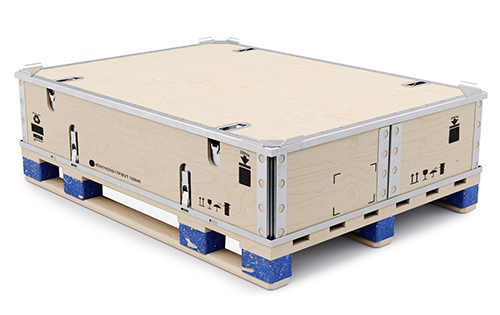Industrial Metal Packaging: Stamina and Resilience in Every Style
Industrial Metal Packaging: Stamina and Resilience in Every Style
Blog Article
Reliable Industrial Recycling Solutions for Sustainable Product Packaging: A Comprehensive Overview
That's where this detailed guide on efficient industrial recycling remedies for lasting product packaging comes in. By discovering vital areas such as product packaging material choice, making for recyclability, applying recycling infrastructure, working together with reusing companions, and monitoring and determining reusing success, this guide will certainly equip you with the expertise and tools needed to make informed decisions and drive positive modification within your company. Whether you're a packaging expert, sustainability supervisor, or simply interested in the subject, this overview will supply valuable insights and approaches to help you navigate the globe of lasting packaging.
Product Packaging Product Option
The option of product packaging products plays a critical role in guaranteeing the sustainability of commercial reusing remedies. When it comes to sustainable packaging, the choice of products is key in minimizing environmental influence and making the most of recycling effectiveness. Selecting the right materials can aid lower waste generation, conserve sources, and advertise a circular economy.
One vital factor to consider in packaging product selection is recyclability - bulk container recycling. Products that can be easily recycled and integrated back right into the production cycle are preferred. Products like cardboard, paper, glass, and certain kinds of plastics can be recycled numerous times without losing their top quality. On the other hand, products that are difficult to recycle, such as non-recyclable composites or blended plastics, can create difficulties for the recycling procedure and may finish up in incinerators or land fills.
An additional consideration is using naturally degradable and renewable materials. Product packaging made from renewable sources, such as plant-based plastics or biopolymers, can help minimize dependence on nonrenewable fuel sources and reduce environment change. Furthermore, biodegradable products break down naturally over time, minimizing the accumulation of waste in garbage dumps.
In addition, the weight and quantity of packaging materials need to be decreased to reduce transportation costs and energy consumption. Light-weight materials not just require fewer resources throughout production but also add to decrease carbon emissions throughout transportation.
Creating for Recyclability
In order to ensure the recyclability of product packaging products, thoughtful style is essential. Creating for recyclability includes producing packaging that can be conveniently sorted, separated, and processed in reusing facilities. One vital facet of developing for recyclability is the option of materials. Packaging developers ought to prioritize the use of materials that are widely accepted for reusing and have developed reusing infrastructures. Materials such as glass, aluminum, and certain kinds of plastic, like animal and HDPE, are commonly reused and need to be favored over products that are expensive or difficult to recycle.
An additional vital consideration in creating for recyclability is the elimination of unneeded elements or products. By lessening the number of layers, coverings, and added parts, product packaging can be made simpler and less complicated to recycle. Additionally, designers ought to aim to decrease using combined products, as they can complicate the recycling process.

Implementing Recycling Infrastructure
Effective execution of reusing facilities is critical for the success of industrial recycling solutions. Without proper infrastructure in position, the reusing procedure becomes ineffective and ineffective, preventing the general objective of lasting product packaging.
To carry out reusing facilities effectively, numerous vital elements require to be considered. Firstly, there should be a well-organized collection system that helps with the splitting up and collection of recyclable products. This can consist of marked reusing bins in public areas, along with collaborations with waste monitoring companies for curbside pickup and sorting.
When collected, the recyclable materials need to be transported to recycling centers in a timely way. This needs efficient logistics and transportation networks, making certain that the materials get to the appropriate centers immediately.
At the recycling centers, progressed sorting and handling modern technologies need to be in location to divide different kinds of products successfully. This includes using automated sorting makers, optical scanners, and hand-operated sorting techniques.
Additionally, there should be a durable market demand for recycled products. This can be accomplished through collaborations with manufacturers and sectors that utilize recycled materials in their production procedures. Creating a steady market for recycled materials incentivizes the reusing sector and advertises the circular economic situation.
Working Together With Recycling Partners

One secret facet of collaborating with reusing companions is the establishment of clear communication networks. It is vital to establish open lines of interaction to facilitate the exchange of info, updates, and comments. This enables both events to remain educated about the progress of reusing efforts and deal with any difficulties or problems that might arise.
Furthermore, partnership can involve collaborations in carrying out and creating reusing programs. Recycling companions can supply useful insights and guidance in creating reliable collection systems and determining the most proper recycling modern technologies. By interacting, organizations and reusing partners can enhance the reusing procedure and decrease waste.
Additionally, cooperation can expand beyond the functional aspects of reusing. It can likewise encompass advocacy and education efforts. By joining forces, businesses and reusing companions can increase recognition concerning the importance of recycling and promote the adoption of sustainable product packaging techniques amongst consumers and various other stakeholders.
Tracking and Measuring Recycling Success
To ensure the performance of commercial reusing solutions and the achievement of sustainable packaging objectives, it is important for companies and their reusing companions to establish an extensive system for tracking and determining recycling success (industrial metal packaging). Measuring and tracking recycling success allows companies to evaluate the impact of their recycling efforts, identify locations for renovation, and established significant targets for future development
One method to track recycling success is through using information collection and evaluation devices. By gathering data on the amount of product packaging waste created, the percentage of waste that is recycled, and the types of products being reused, services can get important insights right into their reusing efficiency. This information can after that be analyzed to determine patterns, patterns, and areas of inefficiency.
One more essential element of tracking and measuring recycling success is establishing clear and standardized metrics. This enables businesses to contrast their performance against sector criteria and track their progress gradually. Metrics such plastic container manufacturer as reusing rates, waste diversion rates, and greenhouse gas exhausts can provide a measurable measure of a company's recycling success.

Verdict
In final thought, implementing effective commercial recycling options for sustainable product packaging requires mindful factor to consider of packaging product selection, making for recyclability, carrying out recycling facilities, working together with reusing partners, and monitoring and measuring reusing success. By incorporating these methods, services can add to an extra sustainable and environmentally-friendly method to product packaging, reducing waste and advertising the circular economic climate.
By exploring crucial locations such as packaging product selection, creating for recyclability, implementing recycling framework, collaborating with recycling companions, and monitoring and gauging reusing success, this guide will certainly outfit you with the expertise and devices required to make educated decisions and drive favorable adjustment within your company. Packaging designers should prioritize the usage of materials that are widely approved for recycling and have developed reusing frameworks.Collaboration with recycling partners is essential for the successful application of commercial reusing solutions and the accomplishment of lasting product packaging objectives. By signing up with pressures, organizations and reusing partners can raise awareness regarding the value of reusing and advertise the fostering of sustainable product packaging techniques amongst customers and various other stakeholders.
By gathering information on the quantity of product packaging waste created, the percent of waste that is reused, and the kinds of materials being recycled, services can get useful understandings into their recycling performance.
Report this page